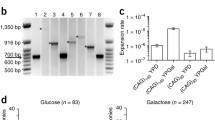Abstract
Trinucleotide repeats undergo contractions and expansions in humans, leading in some cases to fatal neurological disorders. The mechanism responsible for these large size variations is unknown, but replication-slippage events are often suggested as a possible source of instability. We constructed a genetic screen that allowed us to detect spontaneous expansions/contractions of a short trinucleotide repeat in yeast. We show that deletion of RAD27, a gene involved in the processing of Okazaki fragments, increases the frequency of contractions tenfold. Repair of a chromosomal double-strand break (DSB) using a trinucleotide repeat-containing template induces rearrangements of the repeat with a frequency 60 times higher than the natural rate of instability of the same repeat. Our data suggest that both gene conversion and single-strand annealing are major sources of trinucleotide repeat rearrangements.
Similar content being viewed by others
Author information
Authors and Affiliations
Additional information
Received: 8 January 1999 / Accepted: 17 March 1999
Rights and permissions
About this article
Cite this article
Richard, GF., Dujon, B. & Haber, J. Double-strand break repair can lead to high frequencies of deletions within short CAG/CTG trinucleotide repeats. Mol Gen Genet 261, 871–882 (1999). https://doi.org/10.1007/s004380050031
Issue Date:
DOI: https://doi.org/10.1007/s004380050031



